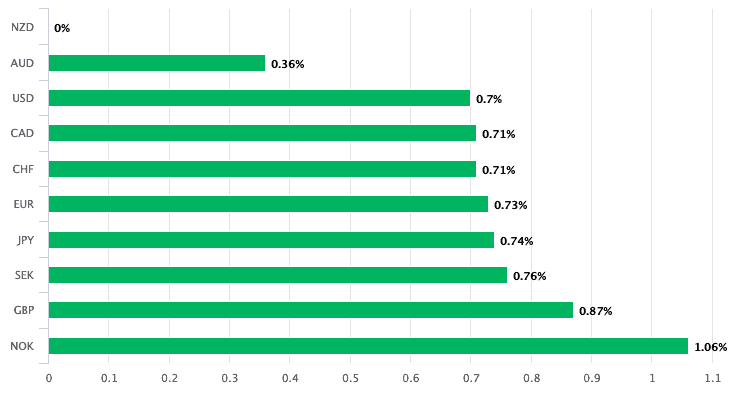New Zealand Dollar Leads the Pack on Lockdown Shift, but "Faces Downside Risks this Week"
- NZ to move to stage level 3 lockdown
- NZD outperforms peers at start of new week
- CBA warn risks are to downside over coming days
- NZ inflation comes in hotter than expected
- Consensus bank GBP/NZD forecasts now available for download at Global Reach

Above: File image of New Zealand Prime Minister Jacinda Ardern. Image © NATO, accessed Flickr
- GBP/NZD market rate today: 2.0558
- Bank transfer rates (indicative): 1.9838-1.9982
- FX specialist rates (indicative): 1.9923-2.0373 >> more information
The New Zealand Dollar lead the field at the start of the new week, rising against all its G10 counterparts on news that the country would be one of the first to ease back on coronavirus lockdown measures.
The government on Monday announced it would aim to conditionally ease restrictions from next Monday night and enter 'level three' covid-19 containment measures. "We have done what very few countries have been able to do. We have stopped a wave of devastation," said New Zealand Prime Minister Jacinda Ardern, when announcing the new measures.
Moving from level four to three means New Zealand will be easing back to normality, thereby avoiding an immediate end to lockdown that would benefit the economy but aid the country's chance at eliminating covid-19.

Above: NZD outperforms its peers at the start of the new week.
With the global currency sphere fixated on the coronacrisis, currencies are expected to outperform if their country exits a state of lockdown earlier than its rivals.
Of course the risk to this over a longer-term period is that those countries hardest hit by the virus have actually achieved herd immunity while countries such as New Zealand become susceptible to a second outbreak.
"The stakes are high. Moving to Alert Level 3 will have near-term benefits for economic activity and sentiment, but the economic damage will be far worse – and longer lasting – if we have to return to Alert Level 4," says Sharon Zollner, Chief Economist at ANZ.
But for now, the playbook seems to favour developments in New Zealand.
"Our four-week lockdown has reaped clear benefits in terms of containing the spread of COVID-19. And it appears that New Zealand is ready to move forward cautiously and ease activity restrictions," says Zollner.
The New Zealand Dollar-U.S. Dollar exchange rate has risen 0.70% to quote at 0.6056 at the time of writing, the Pound-to-New Zealand Dollar exchange rate has meanwhile eased to 2.0559 and the Euro-to-New Zealand Dollar exchange rate to 1.7940.
The Bigger Picture for the New Zealand Dollar
While domestic focus is understandably taking centre stage, it must be remembered that the overall guarantor of New Zealand Dollar value remains global risk sentiment, with the currency tending to rise alongside recovering global stock markets.
As long as markets are in recovery mode we would expect the NZ Dollar to remain supported, but the obvious risk to the currency remains a deterioration in sentiment.
"NZD/USD faces downside risks this week if the USD strengthens in line with our expectations. A global recession, subdued commodity prices and a growing current account deficit are all strong headwinds to NZD," says Joseph Capurso, a foreign exchange strategist with Commonwealth Bank of Australia (CBA).
CBA anticipate poor economic data around the world will steal the spotlight. We also expect US corporate earnings reports will reinforce the bleak economic outlook. "As a result, we expect the USD to lift this week," says Joseph Capurso, foreign exchange strategist with CBA.
CBA expect the "Great Lockdown" to send the US economy into its deepest contraction since 1946 and see U.S. economic data deteriorating further this week.
Any downshift in investor sentiment linked to disappointment here will likely weigh on the Australian Dollar.
CBA expect the April Markit PMIs to plumb to new cyclical lows when numbers are released on Thursday.
Also on Thursday watch initial jobless claims which will be in focus because this week’s instalment will cover the survey period for non‑farm payrolls.
Inflation Comes in Hot, but Should Fade
New Zealand first-quarter 2020 CPI inflation came out at 2.5% year-on-year when released overnight, which is ahead of the 2.1% expected by markets.
Typically such an outcome would boost the value of the NZ Dollar, but future inflation prints are likely to be more relevant as the coronavirus is a large deflationary shock and economists at New Zealand lender ASB expect inflation to fall over the coming one to two years.
Such an event would allow the Reserve Bank of New Zealand (RBNZ) to pursue aggressive monetary policy settings that would ultimately flood the market with freshly-minted New Zealand Dollars.
The RBNZ has already announced its first ever quantitative easing programme that will see it snap up government bonds with newly created money in order to keep the cost of borrowing down.
The standard textbook theory is that when supply of a currency is increased via quantitative easing, its value decreases.
The New Zealand Dollar meanwhile took a dip last week after RBNZ Governor Adrian Orr said he was not opposed to slashing the RBNZ's basic interest rate below 0%, a prospect that further weighs on the currency's outlook.
This brings us back to the direction inflation data adopts: central banks can only print money and slash interest rates in the event that inflation is falling. The RBNZ would have to rapidly backtrack on its intentions if inflationary pressures start to pickup over coming months, which would in turn likely boost the value of the NZD.
However, there is little evidence that inflation is likely to find an upward trajectory in the current global slump, particularly with oil prices continuing to fall.





